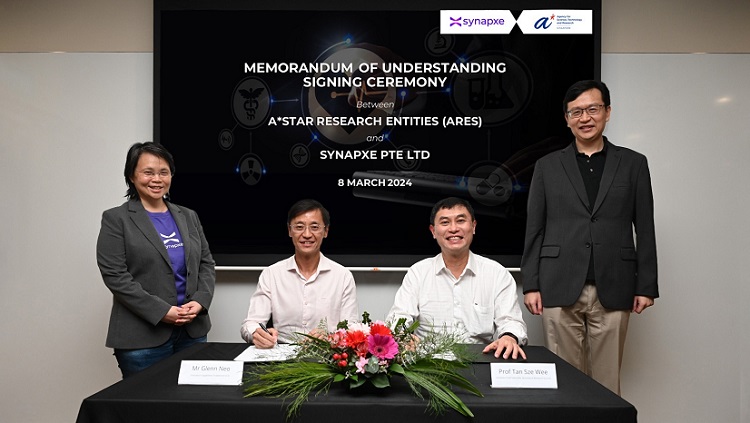
Left to right: Synapxe CEO Ngiam Siew Ying, Synapxe Director of Innovation Capabilities Enablement Glenn Neo, A*STAR Prof Tan Sze Wee, A*STAR CEO Frederick Chew
A locally developed system that uses artificial intelligence to analyse heart scan images can identify conditions in just a few minutes and generate a report within seconds. This is of great help to radiologists who have to analyse hundreds of scanned images every day and can increase work efficiency by up to 20 times.
The new system, APOLLO, was co-developed by the Agency for Science, Technology and Research (A*STAR) in Singapore and multiple local medical and research institutions. Based on 3 million computed tomography (CT) scans of 5,000 local patients, the system trains artificial intelligence to identify various symptoms of heart disease, including cardiac calcification, excess fat tissue, and plaque.
These conditions can be traced on CT scan images. Still, the radiologists responsible for analysis have to look at hundreds of images every day, which is a heavy workload and may miss some symptoms. According to clinical trials, with APOLLO, the rate of missed or delayed diagnoses can be reduced by up to 37%.
The new system analyses CT scan images, saving up to 90% of the time.
In addition, the new system can significantly shorten the analysis time of each CT scan, saving up to 90% of the time, especially for images with complex conditions. Once these CT scan images are uploaded to APOLLO, the system can identify the symptoms within 10 minutes. After verification, the radiologist only needs to click on the computer screen to generate a report within a few seconds.
Like all other medical innovations, developing this system is only the first step. It must be tested and continuously improved based on feedback from radiologists. It can only be widely used by medical institutions once the system stablises.
A*STAR signed a memorandum of understanding with Synapxe on Friday (March 8) to prepare to test APOLLO through the Artificial Intelligence Medical Imaging Diagnostic System (AimSG) platform.
AimSG was launched last year to bring together various local medical imaging artificial intelligence systems. Currently, most of the three major medical clusters are developing and using their systems. AimSG is a nationwide platform. Medical staff from all local public medical institutions can log in to try it out.
Artificial intelligence could ease the manpower crunch for radiologists.
Glenn Neo, Director of Innovation Capabilities Enablement, Synapxe, said that the world is facing a shortage of radiologists, and artificial intelligence can significantly alleviate this problem. However, when it comes to the safety of patients, the diagnostic process must be controlled by professional medical staff, no matter how advanced artificial intelligence is. To ensure that the new system can indeed help radiologists improve their workflow, AimSG places great importance on the collection of user feedback.
Neo said that the medical imaging industry in Singapore leads the world in the application of artificial intelligence. Nevertheless, this industry still has great potential for development. In addition to heart disease, AimSG will bring together artificial intelligence systems for more modalities in the next three years.
Frederick Chew, the Chief Executive of A*STAR, revealed that in addition to medical imaging, A*STAR has also invested heavily in developing new drugs. He is very optimistic about the development prospects of artificial intelligence, believing that artificial intelligence will help direct and progress medical research and development and can make the research and development process "faster, cheaper, and better."
人工智能分析心脏图 几分钟辨识病情出报告工作效率高
本地开发用人工智能分析心脏扫描图像的系统,只需几分钟就可辨识病情,并在数秒内生成报告。这对于每天要分析上百个扫描图像的放射师帮助非常大,工作效率可提高多达20倍。
这个新系统名为APOLLO,由新加坡科技研究局(A*STAR)带领本地多个医疗和研究机构开发。系统以本地5000名病患的300万张电脑断层(CT)扫描为基础,训练人工智能辨识心脏疾病的多种症状,包括心脏钙化、脂肪组织过多、硬斑块(plaque)等。
这些病症在CT扫描图像上都有迹可循,但负责分析的放射师每天得看上百个图像,工作量很大,可能遗漏一些症状。根据临床实验,有了APOLLO,遗漏或延误诊断率可减少达37%。
新系统分析CT扫描图像 省时多达九成
此外,新系统可以极大地缩短每张CT扫描分析的时长,省去的时间可多达九成以上,尤其是病况复杂的图像。只要把这些CT扫描图像上载至APOLLO,系统在10分钟内就能辨识出有什么病症,放射师在核对确认后,只须要点击电脑屏幕,就可在几秒内生成报告。
和所有其他医疗创新一样,这个系统开发完成只是第一步,还须经过测试和根据放射师的反馈不断改善,稳定了才可推广至医疗机构,最终广泛使用。
科技研究局星期五(3月8日)与新联科技(Synapxe)签署谅解备忘录,准备通过人工智能医疗影像诊断系统(AimSG)平台对APOLLO展开测试。
AimSG去年推出,旨在汇集本地各种医疗影像(medical imaging)人工智能系统。目前,三大医疗集群多数各自进行系统开发和运用,AimSG则是一个涵盖全国的平台,本地所有公立医疗机构的医护人员都可以登陆试用。
人工智能可缓解放射师短缺问题
新联科技创新促进处处长梁文声说,全球都面对放射师短缺的情况,人工智能可以很好地缓解这个问题。然而,事关病患的病情和性命,不论人工智能再怎么先进,使用过程都要由专业医护人员把控。为了确保新系统确实能帮助放射师改善工作流程,AimSG非常重视对用户反馈的收集。
梁文声说,本地整体医疗影像业对人工智能的运用处于全球领先地位,然而这个行业仍有很大的发展潜力。除了心脏疾病,AimSG接下来三年将汇集更多科系和病情的人工智能系统。
新科研总裁周继强透露,除了医疗影像,当局也投入大量资源来研发新药物。他对人工智能的发展前景十分乐观,认为人工智能对医疗研发的方向和进度有助力,能使研发过程“更快、更廉宜、更好”。
Source: Lianhe Zaobao © Singapore Press Holdings Limited | Reproduced with permission.
Similar articles:
- Synapxe, A*STAR partner for health tech innovation in Singapore (Singapore Business Review, 8 Mar)
- Synapxe and A*STAR ink MoU to drive collaboration and scalable innovation in HealthTech for Singapore’s healthcare ecosystem (FirstWorld HealthTech, 10 Mar)
